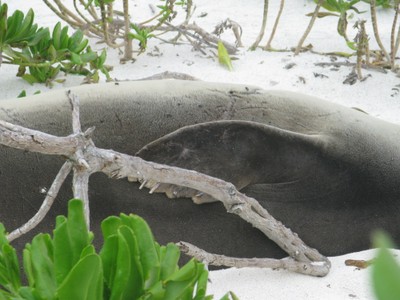Be vewy vewy quiet, I’m hunting monk seals…
Sigh… Another day in paradise. As I set out for breakfast, weaving through the albatross on my beach cruiser bicycle, I mentally run through the day’s itinerary: historical tour of Sand Island in the Midway Atoll followed by the native plant restoration project. Come to find out, the latter half of my day was delightfully interrupted with the opportunity to accompany Tracy Wurth, a National Marine Fisheries Service (NMFS) monk seal research biologist, on a beach survey in search of endangered Hawaiian monk seals Although I felt (a wee bit) guilty abandoning the group and the rewarding task of reclaiming a portion of the island from invasive flora, this is one of the activities I’ve been waiting for since my arrival at Midway.
I hail from Seattle, Washington where I work for the Alaska Ecosystem Program within the National Marine Mammal Laboratory (NMML), which conducts population monitoring and research on northern fur seals and Steller sea lions. In particular, I want to shed light on the habits of these pinnipeds at higher latitudes. When working with these large and surprisingly sprightly animals, you must always exercise caution as they tend to be quite territorial and expressive with their displeasure when being approached by funny looking homo sapiens. For example, the plump, doe-eyed northern fur seal pups have fully earned their nickname: fuzzy black chainsaws. This is why we are outfitted with thick leather welding gloves and gauntlets when conducting pup abundance surveys (not to mention, layers of wool to cut the crisp Alaskan weather).
Given the aforementioned description, you might have some idea of the excitement I felt donning sandals and minimal layers gearing up to walk the white sand beaches looking out at the vivid turquoise water in search of seals with a seasoned monk seal expert. It wasn’t long before we spotted the silvery-grey colored back and lighter creamy underside – our first monk seal! From what I gather, these are the steps for surveying monk seals.

Step One: view from a distance. Unlike the seals you may find in the Main Hawaiian Islands, surrounded by caution tape and snap happy tourists, the Northwest Hawaiian Island monk seals enjoy minimal human interaction owing to their skittish nature.

Tracy scopes out the seal from a safe distance to scan for a flipper tag or bleach mark. Flipper tags are plastic rings with alphanumeric coding assigned to an individual. The tags are color coded to indicate the island where the seal was tagged while the letter used indicates the year. Bleach marks are reapplied annually to known individual seals and are expected to last until the animal’s next molt. Due to the orientation of the animal blocking the view of a tag or bleach mark, further inspection is sometimes necessary…

Step Two: approach slowly. I’m sorry, “approach?!” I exclaim in my head as I flash back to the little fuzzy black chainsaws. In the fashion of Elmer Fudd – except exceptionally less ridiculous and significantly more fashionable – Tracy sneaks away quietly and stealth-like, approaching the seal within mere feet (as a NMFS biologist she is permitted to approach endangered monk seals). She photographs the flipper tag and reappears by my side, the monk seal none the wiser, allowing me to finally release the nervous breath. This seal is sleeping like a baby.

Some individuals are distinguishable by natural markings, such as scars and/or natural bleach spots from which NMFS biologists have built a database for identification of individual seals.

If the animal is identifiable by tag or natural marker and is not yet bleached, proceed to Step Three.

Step Three: bleach that baby! We finally come across an animal that is eligible for bleaching (presence of a flipper tag or natural marking) and that isfast asleep. Now, after having seen the first few approaches, I’m sure that Tracy is safe from these resting beasts and I begin to realize the true difficulty involved in studying such a fragile species. It’s no easy task, channeling your inner ninja to stealthily apply Clairol® bleach to a snoozing seal without disturbing the animal straight into the water, eliminating any chance for the bleach to settle and effectively mark the animal. Observe:
http://www.youtube.com/watch?v=xyLfNuRTTOs
In total, we observed 20 monk seals ranging from the southern part of the island (# 19, South Beach) around to the west side (West Beach) of the island searching the coast line (around to North Beach) to the cargo pier (# 29). Once again – another epic day in paradise…
A Hawaiian monk seal yearling plays lazily on the beach with plastic marine debris (play begins at 20 sec mark)…
http://www.youtube.com/watch?v=F8OprbTtUgs
